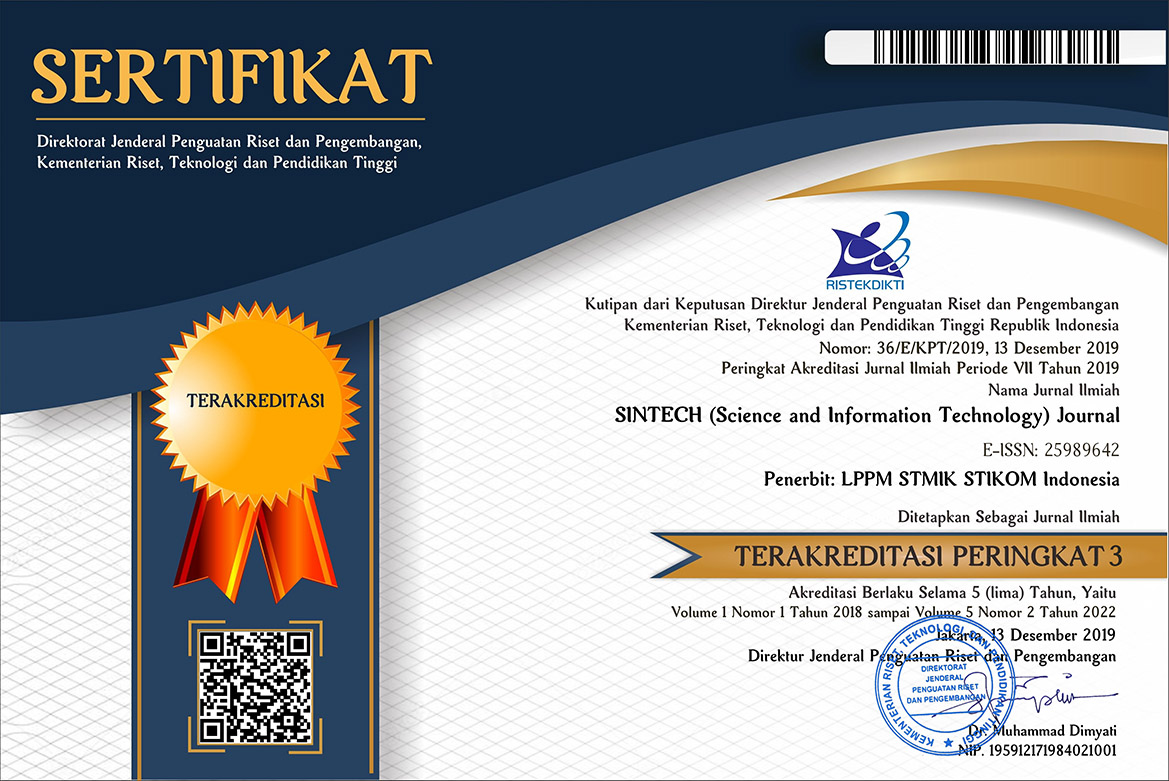MENILAI NIAT PERILAKU MAHASISWA UNTUK MENGGUNAKAN ILIAS SEBAGAI PLATFORM PEMBELAJARAN DARING MENGGUNAKAN MODEL UTAUT2
DOI:
https://doi.org/10.31598/sintechjournal.v4i2.869Keywords:
learning,, online, behavioral intention,, UTAUT 2, ILIASAbstract
The use of e-learning in the learning process at Amikom Purwokerto University has been implemented since early 2019 by utilizing the ILIAS e-learning platform. The problem that arises is whether students are satisfied and intend to continue using the ILIAS platform for the online learning process during the pandemic period and afterwards where there are still many obstacles experienced by students during online lectures. This study aims to assess the behavioral intention of Amikom Purwokerto University students to use ILIAS as an online learning platform by adopting the UTAUT2 (Unified Theory of Acceptance and Use of Technology 2) model. Based on the results of hypothesis testing, it shows that each variable has a significant effect and has a significant impact on the use of ILIAS, this is evidenced by each hypothesis being accepted with a t-value> 1.96. Based on the t-value, the variable Performance Expectancy, Facilitating Condition and Habit is the variable with the highest t-value among the other variables, namely (PE -> BI = 16.8709), (FC -> UB = 13.4742) and (HB - > UB = 12.6896). This shows that these three variables have a high significant influence and impact on the use of ILIAS. In further research, it may be possible to consider the use of moderating variables such as age, gender, experience, and so on or add other variables such as Security and Information Quality.
Downloads
References
I. P. Ramayasa, “Evaluation Model of Success and Acceptance of E-Learning,” J. Theor. Appl. Inf. Technol., vol. 82, no. 3, pp. 462–469, 2015.
R. L. Hasanah, F. F. Wati, and D. Riana, “TAM Analysis on The Factors Affecting Admission of Students for Ruangguru Application,” J. Sist. Inf., vol. 15, no. 2, pp. 1–14, 2019.
W. G. M. Ali, “Nursing Students’ Readiness for e-Learning Experience,” Gynecol. Obstet., vol. 6, no. 6, pp. 1–6, 2016, doi: 10.4172/2161-0932.1000388.
Y.-H. Lee, C. Hsiao, and S. Hadi, “Enhancing e-learning Acceptance: An Empirical Examination on individual and system characteristics,” 2012.
S. Talebian, H. M. Mohammadi, and A. Rezvanfar, “Information and communication technology ( ICT ) in higher education : advantages , disadvantages , conveniences and limitations of applying e-learning to agricultural students in Iran,” Procedia - Soc. Behav. Sci., vol. 152, pp. 300–305, 2014, doi: 10.1016/j.sbspro.2014.09.199.
S. Y. Park, “An Analysis of the Technology Acceptance Model in Understanding University Students’ Behavioral Intention to Use e-Learning,” J. Educ. Technol. Soc., vol. 12, no. 3, pp. 150–162, 2009.
M. Al-okaily, A. Lutfi, A. Alsaad, A. Taamneh, and A. Alsyouf, “Technology in Society The Determinants of Digital Payment Systems’ Acceptance under Cultural Orientation Differences : The Case of Uncertainty Avoidance,” Technol. Soc. J., vol. 63, 2020.
V. Venkatesh, M. G. Morris, M. Hall, G. B. Davis, and F. D. Davis, “User Acceptance of Information Technology : Toward a Unified View,” Psychol. Comput. Sci. MIS Q., vol. 27, no. 3, pp. 425–478, 2003.
M. Indah and H. Agustin, “Penerapan model UTAUT (Unified Theory of Acceptance and Use of Technology) untuk Memahami Niat dan Perilaku Aktual Pengguna Go-Pay di Kota Padang,” J. Eksplor. Akunt., vol. 1, no. 4, pp. 1949–1967, 2019.
J. Ye, J. Zheng, and F. Yi, “A study on users’ willingness to accept mobility as a service based on UTAUT model,” Technol. Forecast. Soc. Chang., vol. 157, 2020, doi: 10.1016/j.techfore.2020.120066.
R. Hoque and G. Sorwar, “Understanding Factors Influencing the Adoption of mHealth by the Elderly : An Extension of the UTAUT Model,” Int. J. Med. Inform., 2017, doi: 10.1016/j.ijmedinf.2017.02.002.
E. Kurilovas and S. Kubilinskiene, “Lithuanian case study on evaluating suitability , acceptance and use of IT tools by students – An example of applying Technology Enhanced Learning Research methods in Higher Education,” Comput. Human Behav., vol. 107, 2020, doi: 10.1016/j.chb.2020.106274.
O. Isaac, Z. Abdullah, A. H. Aldholay, and A. Abdulbaqi, “Antecedents and outcomes of internet usage within organisations in Yemen : An extension of the Uni fi ed Theory of Acceptance and Use of Technology ( UTAUT ) model,” Asia Pacific Manag. Rev., 2018, doi: 10.1016/j.apmrv.2018.12.003.
A. Ayaz and M. Yanartas, “An analysis on the unified theory of acceptance and use of technology theory ( UTAUT ): Acceptance of electronic document management system ( EDMS ),” Comput. Hum. Behav. Reports J., vol. 2, 2020, doi: 10.1016/j.chbr.2020.100032.
K.-C. Yang and P.-H. Shih, “Cognitive age in technology acceptance : At what age are people ready to adopt and continuously use fashionable products ?,” Telemat. Informatics, vol. 51, 2020, doi: 10.1016/j.tele.2020.101400.
A. Gruzd, K. Staves, and A. Wilk, “Connected scholars : Examining the role of social media in research practices of faculty using the UTAUT model,” Comput. Human Behav., vol. 28, pp. 2340–2350, 2012, doi: 10.1016/j.chb.2012.07.004.
R. Madigan, T. Louw, M. Wilbrink, A. Schieben, and N. Merat, “What influences the decision to use automated public transport ? Using UTAUT to understand public acceptance of automated road transport systems,” Transp. Res. Part F Psychol. Behav., vol. 50, pp. 55–64, 2017, doi: 10.1016/j.trf.2017.07.007.
R. Rotikan and A. C. Aseng, “Identifikasi Faktor-Faktor Yang Mempengaruhi Mahasiswa Ilmu Komputer Dalam Mempelajari dan Menggunakan Framework Pemrograman,” Cogito Smart J., vol. 5, no. 1, pp. 79–88, 2019.
F. T. S. Butarbutar and Y. Haryanto, “Kajian Signifikansi Faktor Yang Mempengaruhi Penggunaan E-Learning Pada Siswa SMK Global Informatika Tangerang,” Resti, vol. 1, no. 1, pp. 9–18, 2017.
D. Destaningrum, Suprapto, and N. H. Wardani, “Analisis Faktor Penerimaan Pengguna E-Learning SMA Negeri di Kota Blitar Menggunakan Model Unified Theory of Acceptance and Use of Technology ( UTAUT ),” J. Pengemb. Teknol. Inf. dan Ilmu Komput., vol. 2, no. 2, pp. 723–732, 2018.
B. Budhianto, “Analisis Perkembangan dan Faktor yang Mempengaruhi Keberhasilan Pembelajaran Daring ( E - Learning ),” AgriWidya, vol. 1, no. 1, pp. 11–29, 2020.
B. F. Hutabarat, “Analisis Penerimaan Pengguna Learning Management System Menggunakan Model UTAUT,” J. Sains danSistem Inf. (JUSS ), vol. 3, no. 1, pp. 19–25, 2020.
M. Decman, “Modeling the acceptance of e-learning in mandatory environments of higher education : The influence of previous education and gender,” Comput. Human Behav., vol. 49, pp. 272–281, 2015, doi: 10.1016/j.chb.2015.03.022.
S. Petter, D. Straub, and A. Rai, “Specifying Formative Constructs in Information Systems Research,” MIS Q., vol. 31, no. 4, pp. 623–656, 2007.
N. Urbach and F. Ahlemann, “Structural Equation Modeling in Information Systems Research Using Partial Least Squares,” J. Inf. Technol. Theory Appl., vol. 11, no. 2, pp. 5–40, 2010.
J. C. Anderson and D. W. Gerbing, “Structural Equation Modeling in Practice: A Review and Recommended Two-Step Approach,” Psychol. Bull., vol. 103, no. 3, pp. 411–423, 1988.
C. Fornell and D. F. Larcker, “Evaluating Structural Equation Models with Unobservable Variables and Measurement Error,” J. Mark. Res., vol. 18, no. 1, pp. 39–50, 1981.
Downloads
Published
How to Cite
Issue
Section
License
Copyright (c) 2021 Sarmini, Niken Lia Prihatiningtias Pambayun, Nilam Puspita Nurdewanti

This work is licensed under a Creative Commons Attribution-NonCommercial-ShareAlike 4.0 International License.
Copyright in each article belongs to the author.
- The authors admit that SINTECH Journal as a publisher who published the first time under
 Attribution-NonCommercial-ShareAlike 4.0 International (CC BY-NC-SA 4.0) License.
Attribution-NonCommercial-ShareAlike 4.0 International (CC BY-NC-SA 4.0) License. - Authors can include writing separately, regulate distribution of non-ekskulif of manuscripts that have been published in this journal into another version (eg sent to respository institution author, publication into a book, etc.), by recognizing that the manuscripts have been published for the first time in SINTECH Journal















1.png)




